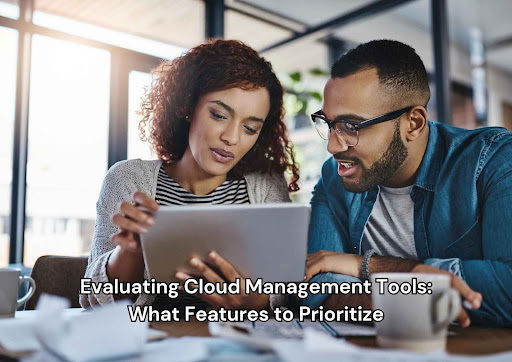Evaluating Cloud Management Tools: What Features to Prioritize

The Growing Complexity of Multi-Cloud Environments
As organizations embrace hybrid and multi-cloud strategies, managing diverse infrastructures becomes increasingly complex. Different cloud platforms provide unique services, pricing models, and performance characteristics. Without a unified approach, teams face fragmented visibility, inconsistent security controls, and unpredictable costs. A robust cloud management services solution addresses these challenges by offering centralized oversight and standardized processes. This article examines the key capabilities that businesses should prioritize when evaluating cloud management tools.
Role of a Comprehensive Cloud Management Services
Cloud management services serve as a single pane of glass for provisioning, monitoring, and optimizing resources across multiple cloud providers. They enable teams to automate repetitive tasks, enforce governance policies, and maintain compliance. These services streamline operations and reduce risk by integrating with development pipelines and security frameworks. The right cloud management services simplify administration and drive cost efficiency and operational agility.
Core Capabilities to Look For
Centralized Resource Provisioning and Orchestration
A primary feature of any cloud management services platform is centralized provisioning. Administrators should be able to deploy virtual machines, containers, storage buckets, and network components from a unified interface. Orchestration workflows automate multi-step processes, such as spinning up an application stack or replicating environments for testing. Policy-based provisioning ensures that resources adhere to organizational standards for naming conventions, tagging, and security configurations.
Dynamic Auto-Scaling and Load Balancing
Cloud management services must support dynamic auto-scaling to maintain performance under variable demand. This capability adjusts compute and storage resources based on real-time metrics such as CPU utilization or request latency. Integration with load balancers ensures that traffic is distributed evenly across instances, preventing bottlenecks and outages. Auto-scaling rules can be customized to scale resources up during peak hours and scale down during off-peak periods, delivering cost savings without sacrificing user experience.
Policy-Driven Governance and Compliance
Enforcing governance policies consistently across multiple clouds is critical for security and compliance. Cloud management services should offer policy engines that define permissible configurations, network topologies, and access controls. Automated policy enforcement prevents the creation of non-compliant resources. Audit logs and compliance reports provide evidence of policy adherence for internal reviews and external audits. By codifying governance rules, organizations reduce manual oversight and mitigate configuration drift.
Automation and Self-Healing Features
Infrastructure as Code and API-First Design
Infrastructure as code (IaC) enables teams to define environment configurations in version-controlled templates. Cloud management services with IaC support allow administrators to provision resources programmatically through APIs or declarative scripts. This approach ensures consistency, repeatability, and rapid recovery. An API-first design makes integrating the platform with CI/CD pipelines, ticketing systems, and custom orchestration logic easy.
Automated Remediation and Self-Healing Workflows
Failures in cloud environments can stem from hardware issues, network errors, or software bugs. Self-healing capabilities automatically detect anomalies and trigger corrective actions. For example, if a virtual machine becomes unresponsive, the platform can reboot or replace it without human intervention. Automated remediation workflows reduce the mean time needed to resolve issues and maintain service availability. Cloud management services should offer prebuilt remediation playbooks and the ability to define custom recovery steps.
Integration with CI/CD Pipelines
Modern software development practices rely on continuous integration and continuous deployment to deliver features rapidly. Cloud management services must integrate seamlessly with CI/CD tools to automate environment provisioning at each stage of the pipeline. This integration allows test environments to mirror production, reducing environment drift. Automated rollbacks triggered by failed deployments further safeguard application stability. By embedding cloud management services into CI/CD workflows, teams achieve faster delivery cycles and lower operational risk.
Visibility, Monitoring, and Analytics
Unified Dashboards for Multi-Cloud Metrics
Visibility is essential when managing resources across multiple cloud providers. A unified dashboard consolidates metrics such as instance health, network latency, and storage utilization. Administrators can create customizable views that display critical data at a glance. With centralized monitoring, teams identify performance degradation and resource bottlenecks before they impact users. Cloud management services should support real-time metrics collection and visualization across all connected environments.
Real-Time Alerts and Anomaly Detection
Proactive monitoring requires alerting mechanisms that notify teams of unusual conditions. Real-time alerts can be configured for threshold breaches, failed health checks, or security events. Anomaly detection algorithms analyze historical patterns to surface deviations that might signal issues such as DDoS attacks or data leaks. Automated notifications via email, SMS, or collaboration platforms like Slack ensure that the right stakeholders respond immediately.
Predictive Analytics for Capacity and Cost Optimization
Predictive analytics uses machine learning to forecast resource demand based on historical usage trends. Organizations can plan capacity expansions, identify underutilized assets, and anticipate cost spikes. Cloud management services with built-in analytics recommend right-sizing instances, resizing storage volumes, or shifting workloads to lower-cost regions. By leveraging predictive insights, businesses optimize budgets and avoid last-minute provisioning bottlenecks.
Security and Compliance
Role-Based Access Control and Identity Management
Securing cloud resources starts with robust identity and access management. Role-based access control (RBAC) enforces the principle of least privilege by granting users only the permissions they need. Integration with identity providers such as LDAP, Active Directory, or SAML ensures single sign-on and multi-factor authentication. Audit logs track user actions for forensic analysis and compliance reporting. Cloud management services should simplify user onboarding and role assignment while maintaining strict security standards.
Automated Compliance Auditing and Reporting
Manual compliance assessments are time-consuming and error-prone. Automated auditing tools within cloud management services scan resources for compliance with standards such as PCI DSS, HIPAA, or ISO 27001. The platform generates detailed reports that highlight non-compliant configurations and provide remediation guidance. Scheduling regular audits ensures ongoing compliance and reduces the burden of surprise inspections.
Encryption and Data Protection Across Environments
Protecting data at rest and in transit is a non-negotiable requirement. Cloud management services should offer automated encryption of storage volumes, database instances, and object buckets using provider-managed or customer-managed keys. Network encryption via TLS and VPN configurations secures data moving between regions and on-premises systems. Configuration templates enforce encryption settings by default, preventing unencrypted resources from being deployed.
Cost Management and Optimization
Real-Time Cost Tracking and Budget Alerts
Uncontrolled cloud spending can erode ROI. Cloud management services provide real-time cost tracking at the account, project, and resource level. Budget alerts notify teams when spending approaches predefined thresholds. Detailed cost breakdowns show service, region, or application expenses, enabling data-driven optimization decisions. By monitoring costs continuously, organizations avoid bill shock and maintain financial discipline.
Rightsizing Recommendations and Reserved Instance Planning
Automatic rightsizing analyzes usage patterns and recommends instance type or size adjustments. Cloud management services evaluate idle or underutilized resources and suggest resizing or terminating them. Reserved instance planning tools forecast long-term usage and recommend commitments that deliver significant cost savings. Integrating these recommendations into regular operational reviews maximizes budget efficiency.
Chargeback and Showback Capabilities
In multi-team or multi-department environments, cost transparency encourages accountability. Chargeback assigns actual cloud costs to business units based on resource usage. Showback reports inform teams of their consumption without billing them directly. Either model fosters cost-conscious behavior and supports internal chargeback processes. Cloud management services streamline cost allocation and reporting, simplifying budget reconciliation.
Extensibility and Integrations
Prebuilt Connectors for Popular Cloud Providers
Seamless integration with leading cloud platforms such as AWS, Azure, and Google Cloud is essential. Cloud management services offer prebuilt connectors that import resource inventories, metrics, and billing data automatically. These connectors reduce configuration effort and ensure up-to-date visibility across all environments. Support for emerging providers expands flexibility as organizational needs evolve.
Marketplace Ecosystems and Third-Party Plugins
A vibrant ecosystem of plugins and extensions enhances the platform’s capabilities. Marketplace offerings include security scanners, data backup tools, and cost-management utilities. Third-party integrations with monitoring tools, ITSM systems, and DevOps platforms enable end-to-end automation and collaboration. Organizations should evaluate the availability and maturity of ecosystem components when selecting a cloud management services provider.
Custom Scripting and SDK Support
No two environments are identical. Custom scripting and SDKs allow teams to implement specialized workflows, integrate proprietary systems, or trigger automated actions based on business logic. Cloud management services should provide rich APIs, software development kits, and documentation to empower administrators and developers to extend the platform’s functionality as needed.
Vendor Evaluation Criteria
Service-Level Agreements and Support Models
Reliable support underpins successful cloud operations. Cloud management services vendors publish service-level agreements that guarantee platform availability, support response times, and feature update cadences. Organizations should assess support models from community forums to dedicated enterprise support to ensure vendor commitments align with business requirements.
Community Adoption and Ecosystem Maturity
A strong user community and a mature ecosystem indicate platform stability and longevity. Active forums, user conferences, and frequent third-party integrations demonstrate broad adoption. Peer reviews, case studies, and analyst reports provide insights into vendor reputation and roadmap credibility. Organizations benefit from platforms with engaged communities that share best practices and contribute to ongoing innovation.
Total Cost of Ownership and Licensing Flexibility
Beyond subscription fees, the total cost of ownership includes implementation expenses, training, and ongoing maintenance. Licensing models such as usage-based, tiered subscriptions, or perpetual licenses impact budget predictability. Cloud management services that offer flexible licensing, usage discounts, or value-add bundles better align with diverse organizational needs.
Best Practices for Tool Selection
Conducting a Proof of Concept
A proof of concept validates that the selected cloud management services platform meets real-world requirements. Key evaluation criteria include ease of deployment, integration with existing toolchains, and performance under load. Pilot projects uncover potential limitations early and guide configuration best practices.
Involving Cross-Functional Stakeholders
Successful tool adoption requires input from development, operations, security, and finance teams. Cross-functional workshops define use cases, establish success metrics, and create buy-in. Cloud management services that satisfy diverse stakeholder needs are more likely to achieve broad adoption and long-term success.
Establishing Success Metrics and KPIs
Defining clear key performance indicators—such as deployment frequency, incident resolution time, compliance audit pass rates, and cost savings—provides objective measures of platform effectiveness. Regularly tracking these KPIs ensures that cloud management services deliver tangible business value and align with organizational objectives.
Crafting a Resilient Cloud Strategy
Selecting the right cloud management services platform involves balancing comprehensive feature sets with ease of use and integration flexibility. Prioritizing centralized provisioning, dynamic auto-scaling, robust security controls, and cost-management capabilities ensures a resilient multi-cloud strategy. Extensibility, strong vendor support, and a vibrant ecosystem further enhance long-term success. Organizations that align tool selection with clear business goals and involve cross-functional teams will unlock the full potential of cloud operations. For expert guidance on evaluating and implementing modern cloud management services, please reach out to sales@zchwantech.com.



